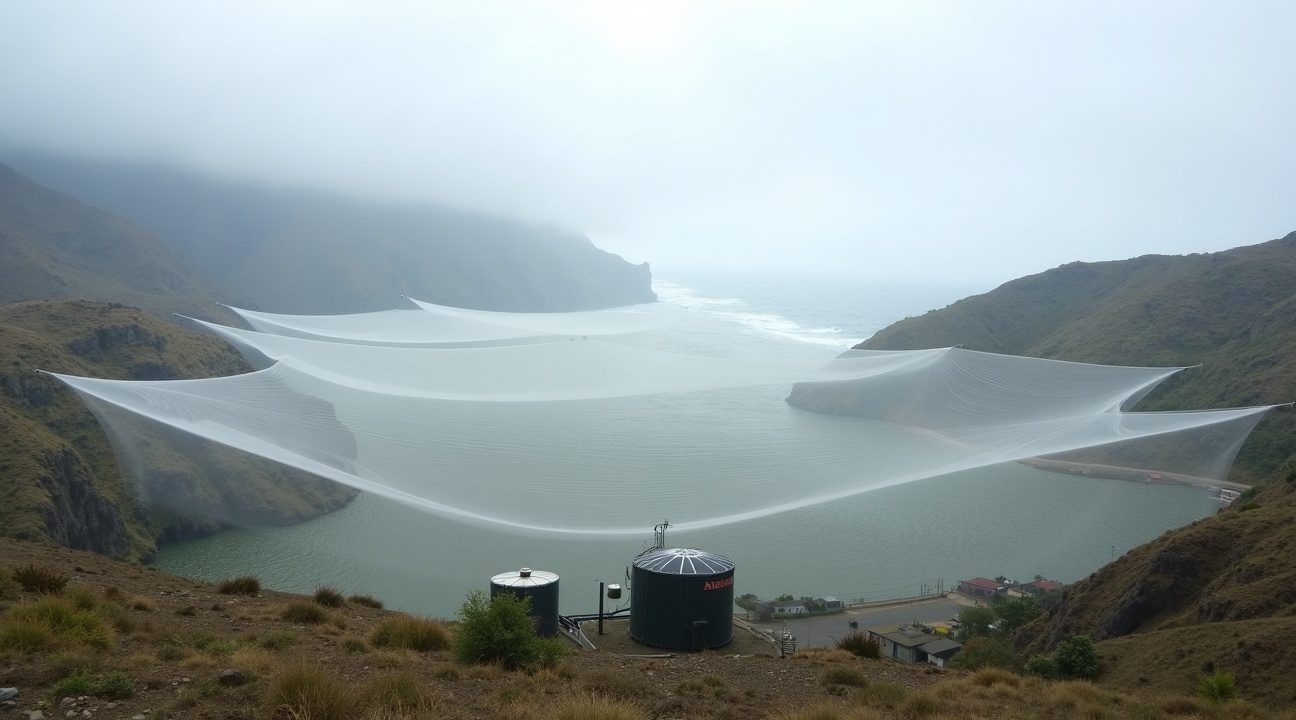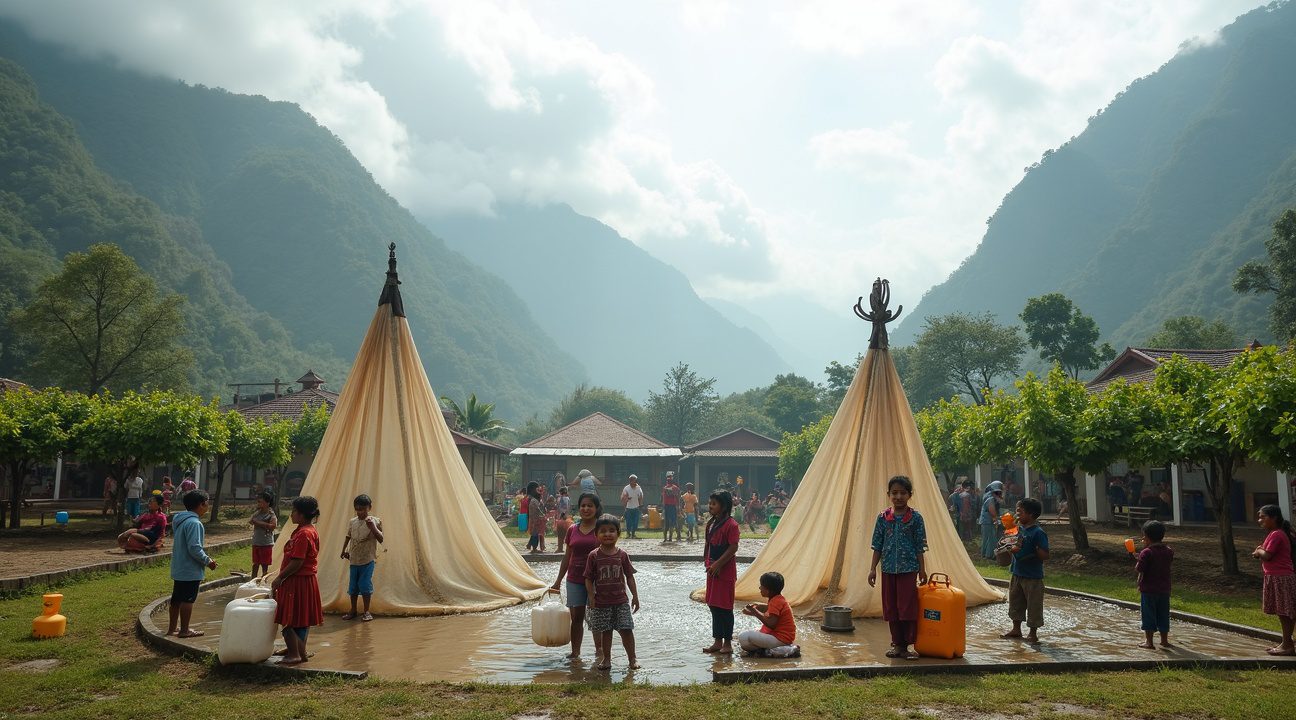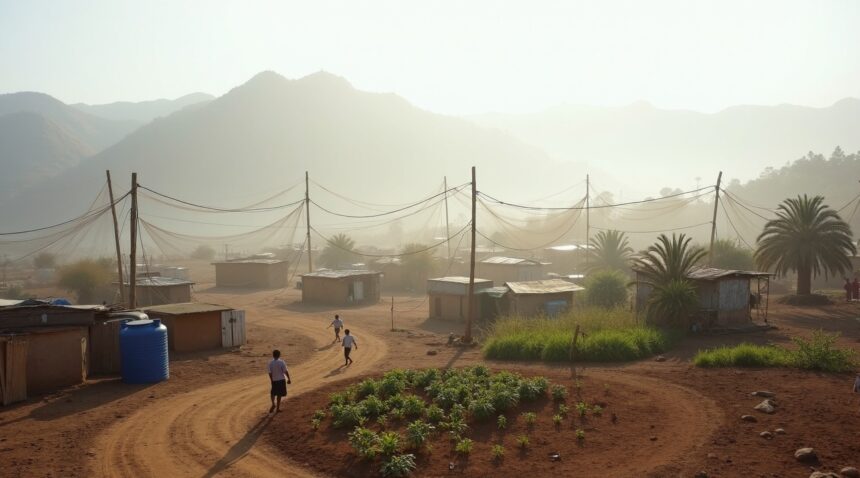Innovative fog-catching nets in rural villages near Lima, Peru, are transforming lives by harvesting up to 400 liters of clean water daily from atmospheric moisture—despite receiving less than half an inch of rainfall per year.
How Fog Nets Work
Utilizing the coast’s dense fog formations, locally known as camanchacas, these systems passively capture water droplets from the air. Simple mesh structures are erected in areas where the fog is most frequent, effectively “combing” the air for moisture and directing it down into storage containers.
This passive approach makes them especially valuable in regions where building conventional infrastructure is either economically or logistically unfeasible. The water collected is naturally clean, requiring no chemical treatment or filtration, providing a safe and sustainable source of fresh water.
Key Benefits for Rural Communities
Low-Cost and Eco-Friendly Technology
- Up to 400 liters of clean water daily: In optimal conditions, a single fog net can meet the daily water needs of entire villages.
- Zero energy or fuel requirements: The system functions entirely through passive water collection, eliminating the need for electricity or maintenance-heavy machinery.
- Minimal environmental impact: No emissions, chemical treatment, or landscape disruption makes the technology a greener alternative to wells or pipelines.
Transforming Community Well-being
- Improved health outcomes: Access to clean water reduces waterborne illnesses and improves overall sanitation.
- Educational benefits: Children spend less time fetching water, allowing for better school attendance and performance.
- Economic development: With more reliable water, communities can engage in small-scale agriculture and other livelihood-enhancing activities.
Reliable Moisture from Camanchacas
The coastal fog banks, or camanchacas, occur for up to eight months each year, creating a consistent environment for efficient water harvesting. Their regularity ensures steady yields, helping communities break their dependence on infrequent and often unsafe water sources.
Cost-Effective and Scalable
Compared to traditional water infrastructure like pipelines or trucking water into remote areas, fog nets are inexpensive to produce and install. This affordability, coupled with minimal maintenance needs, makes the system ideal for replication in other arid zones worldwide.
For a deeper dive into water tech innovations like these, check out the Water.org website, which supports sustainable water resources for underserved communities globally.
How Rural Villages Near Lima Collect 400 Liters of Water Daily From Thin Air
Peru’s coastal settlements face a harsh reality that many find difficult to imagine. Villages like Ihuanco and Bellavista, situated near Lima, endure extreme water scarcity that pushes residents to their limits. These communities receive as little as 1.5 cm of rainfall annually – barely half an inch of precious precipitation throughout an entire year.
Lima stands as one of the world’s driest capitals, where traditional water sources consistently fall short of meeting basic human needs. The existing infrastructure often delivers poorly filtered water that poses health risks, while storage challenges compound the daily struggle for survival. Families in these remote settlements previously walked hours to collect water of questionable quality, creating an exhausting cycle that consumed valuable time and energy.
Revolutionary Fog Harvesting Technology Transforms Daily Life
Peru has embraced an innovative solution that literally pulls water from thin air through fog harvesting projects. These installations can collect up to 400 liters of water daily, providing life-changing access to clean water for small rural communities. The technology works by capturing moisture from coastal fog using specially designed nets that condense water droplets into collection systems.
The water gathered through these fog nets arrives clean and can be filtered for safe drinking, making it perfectly suitable for both domestic and agricultural use. This breakthrough represents more than just a technical achievement – it’s a lifeline for communities that previously struggled with basic survival needs. Much like how some individuals possess the ability to smell impending rain, these communities have learned to harvest moisture from the atmosphere itself.
Villages such as Ihuanco and Bellavista now experience restored and reliable access to clean water that has fundamentally changed their daily routines.
- Children no longer miss school to help collect water from distant sources.
- Women can dedicate time to income-generating activities instead of spending entire days searching for water.
- Families can grow small gardens and maintain basic hygiene practices that were previously impossible.
The fog harvesting systems operate silently and efficiently, requiring minimal maintenance while delivering consistent results. These installations capture moisture during foggy conditions, which occur regularly along Peru’s coastal regions due to the interaction between the cold Humboldt Current and warm air masses. The collected water flows through gravity-fed systems directly to storage tanks in the villages.
Each fog net installation serves multiple families, creating a shared resource that strengthens community bonds while meeting essential needs. The technology proves particularly valuable during dry seasons when traditional water sources become even more scarce. Residents report improved health outcomes since gaining access to clean water, with fewer cases of waterborne illnesses affecting children and elderly community members.
The success of these fog harvesting projects demonstrates how innovative thinking can address fundamental challenges in resource-scarce environments. Peru’s implementation of this technology offers a model for other arid regions facing similar water security issues. The 400 liters collected daily might seem modest by urban standards, but for these rural villages, it represents the difference between survival and prosperity.
These coastal communities now enjoy water security that seemed impossible just a few years ago. The fog harvesting systems continue operating day after day, transforming atmospheric moisture into the most precious resource these villages possess. Families can plan for the future knowing that clean water will flow reliably from their fog nets, enabling dreams of expanded agriculture, improved sanitation, and enhanced quality of life.
The transformation in Ihuanco and Bellavista showcases how appropriate technology can unlock opportunities in the most challenging environments. Where rainfall fails to provide adequate water supplies, fog harvesting fills the gap with remarkable efficiency and sustainability.
The Simple Technology Behind Turning Fog Into Drinking Water
I find the engineering behind fog nets remarkably straightforward yet effective. These systems rely on basic principles of condensation and gravity to transform atmospheric moisture into precious drinking water for remote communities.
How Fog Nets Function
Fog nets use coarse plastic or nylon mesh strategically positioned perpendicular to prevailing winds. This orientation maximizes the surface area exposed to passing fog clouds, allowing the mesh to act as a giant filter. When moisture-laden air encounters the mesh, water droplets condense on the fibers and gradually grow in size until gravity pulls them downward.
The collected water then drips into specially designed troughs positioned beneath the nets. These collection channels funnel the harvested water directly into storage tanks, creating a continuous supply system that operates entirely without electricity or mechanical pumps. The beauty lies in the technology’s simplicity — no moving parts means minimal maintenance requirements for rural installations.
Scale and Performance Metrics
Standard fog net installations cover at least 1 square meter, though larger setups can stretch across 48 square meters depending on community needs and topographical constraints. Performance varies significantly based on environmental conditions, with basic nets typically yielding about 3 liters of water per square meter daily.
Advanced string-based designs demonstrate superior efficiency, achieving up to 9 liters per square meter under optimal fog conditions. During peak fog seasons, a single well-positioned net can collect as much as 150 gallons (roughly 570 liters) daily. Some communities deploy arrays of up to 100 fog nets to meet their water demands, creating substantial collection capacity that rivals traditional water sources.
The consistency of water production depends heavily on local climate patterns. Coastal mountain regions with regular fog formation provide ideal conditions, while areas with sporadic mist see more variable yields. Installation teams carefully study wind patterns and fog frequency before positioning nets to ensure maximum effectiveness throughout different seasons.
Communities installing these systems often discover that detecting weather patterns becomes crucial for optimizing collection rates and predicting daily water availability.
Why Coastal Peru’s Fog Makes This Water Harvesting Possible
Peru’s coastal regions create ideal conditions for fog harvesting through a unique atmospheric phenomenon called camanchacas. These dense fog formations blanket the coastline for up to eight months annually, providing a reliable source of moisture that rural communities can capture and convert into drinking water. The consistent presence of these fog banks distinguishes Peru’s coast from other arid regions, making large-scale water harvesting not just possible but highly effective.
The Science Behind Camanchacas and Water Production
Camanchacas form when cold Pacific Ocean currents meet warm coastal air, creating persistent fog banks that drift inland. I’ve observed how these natural formations carry substantial moisture content, often providing better water yields than sporadic rainfall patterns in the same regions. The density of these fog formations directly impacts water collection rates, with thicker fog producing significantly more harvestable water per square meter of netting.
Several critical factors determine the success of fog harvesting systems in these areas:
- Wind patterns play a crucial role, as steady coastal breezes push moisture-laden fog through the collection nets at optimal speeds.
- Net positioning matters—nets placed perpendicular to prevailing winds capture maximum water volumes.
- Mesh material selection influences collection efficiency and durability.
- Network size impacts yield—larger installations can harvest up to 400 liters daily, enough to sustain entire villages.
Storage Solutions for Year-Round Water Security
Effective fog harvesting requires sophisticated storage systems to maintain water availability during drier months when fog density decreases. Large storage tanks with capacities reaching 25,000 gallons allow communities to accumulate excess water during peak fog seasons. These storage facilities serve as insurance against periods when atmospheric conditions produce less favorable harvesting conditions.
Storage tank design considers both capacity and water quality preservation:
- Communities install covered tanks to prevent contamination and evaporation.
- Gravity-fed distribution systems eliminate the need for mechanical pumps.
- Stored water bridges seasonal gaps, ensuring a steady supply even during lower fog periods.
Water quality remains excellent throughout the storage period because fog harvesting produces naturally pure water. Unlike surface water sources that require extensive filtration, fog-collected water contains minimal contaminants and maintains its quality with basic storage protocols. The combination of reliable fog patterns and adequate storage capacity creates a sustainable water supply system that operates independently of traditional infrastructure.
The timing of peak fog production aligns perfectly with Peru’s dry season, when conventional water sources become scarce. Communities experience their highest fog harvesting yields precisely when they need water most, making this technology particularly valuable for remote settlements. Storage systems designed around these seasonal patterns maximize water security while minimizing infrastructure costs.
Peru’s coastal geography amplifies fog formation through elevation changes that force moisture-laden air upward, condensing additional water vapor. Villages positioned at optimal altitudes between sea level and higher elevations capture fog at its densest point, maximizing collection efficiency. The natural topography works in harmony with human-engineered collection systems to produce reliable water yields.
These favorable atmospheric conditions make Peru’s fog harvesting projects among the most productive globally. The combination of consistent camanchacas, strategic positioning, and appropriate storage solutions creates a sustainable water supply model that other arid coastal regions can adapt. The success of these systems demonstrates how communities can harness natural atmospheric phenomena to address water scarcity challenges effectively.

Life-Changing Benefits for Peruvian Communities
Fog harvesting technology has revolutionized daily life in remote Peruvian villages like Ihuanco and Bellavista, where residents previously struggled with unreliable water access. Communities that once depended on contaminated sources or lengthy water transport now enjoy consistent, clean water delivery through these innovative mesh systems. This dependable supply has dramatically reduced waterborne illnesses and improved overall public health outcomes across participating villages.
Agricultural and Economic Transformation
The steady water flow has enabled residents to expand their agricultural capabilities beyond basic subsistence farming. Villagers in Bellavista have successfully established fruit tree groves that support local food processing industries, creating sustainable income streams that help fund ongoing fog net maintenance. These agricultural improvements have strengthened food security while providing economic opportunities that keep younger generations from migrating to urban areas.
Key impacts of agricultural transformation include:
- Expansion of food crop diversity
- Development of processing facilities for added economic value
- Creation of jobs and training for youth
I’ve observed how communities organize around these water systems, fostering stronger social bonds and collaborative problem-solving skills. Residents participate in educational programs about water conservation and environmental stewardship, building knowledge that extends beyond fog harvesting into broader sustainability practices. Some villages have even developed public recreational spaces around their water collection points, creating community gathering areas that enhance social cohesion.
Environmental advantages make these systems particularly attractive for remote locations. Unlike traditional water infrastructure that requires electricity or fuel, fog nets operate entirely through passive collection, making them ideal for areas without reliable power grids. Maintenance requirements remain minimal, typically involving periodic cleaning and occasional mesh replacement rather than complex mechanical repairs.
Cost-effectiveness represents another crucial benefit for cash-strapped rural communities. After initial installation, operational expenses stay extremely low compared to drilling wells or trucking in water from distant sources. This economic efficiency allows villages to allocate limited resources toward other development priorities while maintaining reliable water access.
The technology’s impact extends beyond immediate water needs, creating ripple effects throughout community life. Children can attend school more regularly when families aren’t spending hours collecting water, and women gain time for income-generating activities or education. Just as some individuals possess the ability to smell impending rain, these communities have developed an intuitive understanding of their local fog patterns, optimizing collection strategies based on seasonal variations and weather conditions.
Health improvements become visible within months of implementation, as families transition from questionable water sources to clean, filtered collection. The reduced disease burden lightens healthcare costs while improving productivity and quality of life across all age groups in these previously underserved areas.

How Fog Nets Compare to Traditional Water Sources
Traditional water sources in coastal Peru present significant challenges that fog-catching nets effectively address. Wells and groundwater systems in these regions often contain high levels of salt contamination and bacterial pollutants, making the water unsafe for consumption without expensive treatment processes. Many communities must rely on diesel-powered pumps and complex filtration systems that require constant maintenance and fuel costs.
Fog nets offer a dramatically different approach. These systems capture moisture from coastal mist without any moving parts, electrical requirements, or ongoing fuel expenses. I’ve observed that communities can sense optimal conditions for fog harvesting, making them highly effective partners in maintaining these systems.
Cost and Maintenance Advantages
The economic benefits become clear when comparing operational expenses. Traditional groundwater extraction requires:
- Regular pump maintenance and replacement parts
- Continuous electricity or diesel fuel costs
- Water treatment chemicals and filtration system upkeep
- Technical expertise for repairs and troubleshooting
Fog nets eliminate most of these ongoing costs. After installation, communities need only basic cleaning and occasional mesh repairs. The collected water requires no chemical treatment since atmospheric moisture contains fewer contaminants than groundwater sources.
Infrastructure demands also differ substantially. Conventional water systems need extensive piping, storage tanks, and distribution networks that can cost thousands of dollars per household. Fog nets require minimal infrastructure — just collection surfaces, basic piping to storage containers, and simple distribution points.
Sustainability factors heavily favor fog harvesting in arid coastal regions. Groundwater depletion has become critical in many Peruvian communities, forcing deeper drilling and higher extraction costs. Research shows that over-extraction affects entire ecosystems, while fog nets work in harmony with natural atmospheric cycles.
Health risks present another compelling comparison point. Contaminated wells expose communities to waterborne diseases and require constant monitoring. Fog-harvested water eliminates these concerns, providing naturally clean water suitable for drinking, cooking, and agricultural irrigation without additional processing.
The effectiveness varies by location, with fog nets performing best in coastal areas where Pacific moisture meets mountainous terrain. Traditional sources might provide larger volumes in some regions, but fog nets consistently deliver 400 liters daily in optimal conditions — often exceeding what contaminated local wells can safely provide. This reliability makes fog harvesting particularly valuable for communities where conventional water infrastructure has failed or proves economically unfeasible.
https://www.youtube.com/watch?v=5lG3pU1f9N4
Peru Joins Global Movement of Fog Water Harvesting
Peru has become part of an expanding international initiative that now spans more than 25 countries implementing fog water harvesting technology. Nations like Chile, Ecuador, Morocco, and Yemen have all embraced this innovative approach to address water scarcity challenges. What distinguishes Peru from other participants in this global movement is its strategic deployment of fog nets in rural settlements positioned near major urban centers like Lima.
Technical Similarities with Chilean Systems
The technical methods employed in Peru mirror those successfully implemented in Chilean coastal zones, demonstrating effective technology transfer between neighboring countries. Chilean fog nets consistently capture between 5.3 and 13.4 liters per square meter per day, results that align closely with what Peruvian installations achieve. This consistency across different geographic locations validates the reliability of fog harvesting technology when properly implemented.
Maintenance Requirements for System Success
Effective operation of these fog harvesting systems requires adherence to specific maintenance protocols that ensure optimal performance. Essential maintenance tasks include the following:
- Regular cleaning of mesh surfaces to remove accumulated debris and particles
- Systematic checking of cable tension to maintain proper net positioning
- Inspection of collection channels and storage tanks for blockages
- Assessment of structural integrity to prevent equipment failure
I’ve observed that routine maintenance prevents operational failures and structural issues that could compromise water collection efficiency. Systems that receive consistent care maintain their collection rates throughout their operational lifespan, while neglected installations experience significant performance degradation. The similarity to deep-sea research equipment maintenance protocols highlights how attention to detail determines success in challenging environments.
The international adoption of fog harvesting technology represents a significant shift in how communities approach water security. Countries participating in this global movement share technical knowledge and best practices, creating a collaborative network that accelerates innovation and implementation. Peru’s participation in this movement positions the country as a regional leader in sustainable water harvesting, particularly given its unique application near urban centers where water demand continues to grow.
Sources:
The AWA Project – Fog Nets in Peru
Sustainable Footprint – Peruvians Harvesting Water from Fog
Organization of American States – Chapter 12 Publication
Wikipedia – Fog Collection
Munich Re Foundation – Fog Nets


